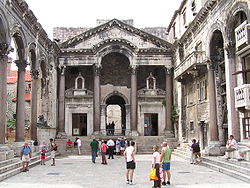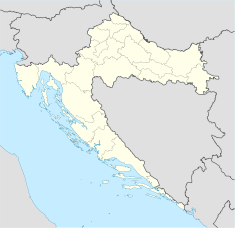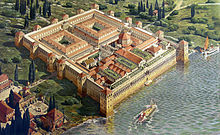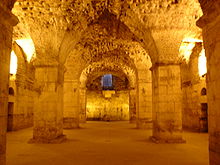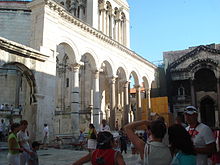- Diocletian's Palace
-
Historical Complex of Split with the Palace of Diocletian Location: Split, Croatia Coordinates: 43°30′29″N 16°26′18″E / 43.50806°N 16.43833°ECoordinates: 43°30′29″N 16°26′18″E / 43.50806°N 16.43833°E Built: 4th century UNESCO World Heritage Site Type: Cultural Criteria: ii, iii, iv Designated: 1979 (3rd Session) Reference #: 97 State Party:  Croatia
CroatiaRegion: Europe and North America Cultural Good of Croatia Official name: Dioklecijanova palača Diocletian's Palace (Croatian: Dioklecijanova palača, pronounced [diɔklɛt͡sijǎːnɔʋa pǎlat͡ʃa]) is a building in Split, Croatia, that was built by the Roman emperor Diocletian at the turn of the fourth century AD.
Diocletian built the massive palace in preparation for his retirement on 1 May 305 AD. It lies in a bay on the south side of a short peninsula running out from the Dalmatian coast, four miles from Salona, the capital of the Roman province of Dalmatia. The terrain slopes gently seaward and is typical karst, consisting of low limestone ridges running east to west with marl in the clefts between them.
Contents
History
After the Romans abandoned the site, the Palace remained empty for several centuries. In the 7th century nearby residents fled to the walled palace to escape invading barbarians. Since then the palace has been occupied, with residents making their homes and businesses within the palace basement and directly in its walls.[1] Today many restaurants and shops, and some homes, can still be found within the walls.
After the Middle Ages the palace was virtually unknown in the West until the Scottish neo-classical architect Robert Adam had the ruins surveyed and, with the aid of French artist and antiquary Charles-Louis Clérisseau and several draughtsmen, published Ruins of the Palace of the Emperor Diocletian at Spalatro in Dalmatia (London, 1764). Diocletian's palace was an inspiration for Adam's new style of Neoclassical architecture[2] and the publication of measured drawings brought it into the design vocabulary of European architecture for the first time. A few decades later, in 1782, the French painter Louis-François Cassas created drawings of the palace, published by Joseph Lavallée in 1802 in the chronicles of his voyages.[3]
This palace is today, with all the most important historical buildings, in the centre of the city of Split. Diocletian's Palace far transcends local importance because of its degree of preservation. The Palace is one of the most famous and complete architectural and cultural features on the Croatian Adriatic coast. As the world's most complete remains of a Roman palace, it holds an outstanding place in Mediterranean, European and world heritage.
Cultural heritage
In November 1979 UNESCO, in line with the international convention on cultural and natural heritage, adopted a proposal that the historic city of Split built around the Palace should be included in the register of World Cultural Heritage.[4]
In November 2006 the City Council decided to permit over twenty new buildings within the palace (including a shopping and garage complex), despite the fact that the palace had been declared a UNESCO World Heritage Monument. It is said that this decision was politically motivated and largely due to lobbying by local property developers. Once the public in 2007 came aware of the project, they petitioned against the decision and won. No new buildings, shopping center or the underground garage was built.
The World Monuments Fund has been working on a conservation project at the palace, including surveying structural integrity and cleaning and restoring the stone and plasterwork, expected to be completed in 2009. Much restoration is still needed, including excavating the extensive basement which was buried during the bombardment by the allies in World War II.[dated info]

The palace is depicted on the reverse of the Croatian 500 kuna banknote, issued in 1993.[5]
Architecture
The ground plan of the palace is an irregular rectangle (approximately 160 meters x 190 meters) with towers projecting from the western, northern, and eastern facades. It combines qualities of a luxurious villa with those of a military camp, with its huge gates and watchtowers. The palace is enclosed by walls, and at times, it housed over 9000 people. Subterranean portions of the palace feature barrel vaulted stonework.
Only the southern facade, which rose directly from, or very near to, the sea, was unfortified. The elaborate architectural composition of the arcaded gallery on its upper floor differs from the more severe treatment of the three shore facades. A monumental gate in the middle of each of these walls led to an enclosed courtyard. The southern sea gate (the Porta Aenea) was simpler in shape and dimensions than the other three, and it is thought that it was originally intended either as the emperor's private access to the sea, or as a service entrance for supplies.
The design is derived from both villa and castrum types, and this duality is also evident in the arrangement of the interior. The transverse road (decumanus) linking the eastern gate (the Silver Gate or Porta argentea) and western gate (the Iron Gate or Porta ferrea) divided the complex into two halves. In the southern half were the more luxurious structures; that is, the emperor's apartments, both public and private, and religious buildings. The emperor's apartments formed a block along the sea front and were situated above a substructure because the sloping terrain demanded significant differences in level. Although for many centuries almost completely filled with refuse, most of the substructure is well preserved, and indicates the original shape and disposition of the rooms above.
A monumental court, called the Peristyle, formed the northern access to the imperial apartments. It also gave access to Diocletian's mausoleum on the east (now Cathedral of St. Domnius), and to three temples on the west (two of which are now lost, the third having become a baptistery, originally being the temple of Jupiter).There is a temple just to the west of the Peristylum called The Temple of the Aesculapius, which has a semi cylindrical roof made out of hand carved stone blocks which did not leak until the 1940s, and was then covered with a lead roof. The temple was restored recently.
The northern half of the palace, divided in two parts by the main north-south street (cardo) leading from the Golden Gate (Porta aurea) to the Peristyle, is less well preserved. It is usually supposed that each part was a residential complex, housing soldiers, servants, and possibly some other facilities. Both parts were apparently surrounded by streets. Leading to perimeter walls there were rectangular buildings, possibly storage magazines.
The Palace is built of white local limestone and marble of high quality, most of which was from Brač marble quarries on the island of Brač, of tuff taken from the nearby river beds, and of brick made in Salonitan and other factories. Some material for decoration was imported: Egyptian granite columns and sphinxes, fine marble for revetments and some capitals produced in workshops in the Proconnesos.
Notes
Water for the palace came from the Jadro River near Salona. Along the road from Split to Salona impressive remains of the original Roman aqueduct can still be seen. They were extensively restored in the 19th century.
See also
- Marjan
- Roman architecture
- List of Roman domes
- Red Peristyle (an act of urban intervention done on the main square of the palace)
- Dalmatia
References
- ^ http://www.croatiatraveller.com/Heritage_Sites/Diocletian'sPalace.htm
- ^ Hogan, C. Michael, "Diocletian's Palace", The Megalithic Portal, A. Burnham ed., 6 Oct 2007.
- ^ Voyage pittoresque et historique de l'Istrie et de la Dalmatie rédigé d'après l'Itinéraire de L. F. Cassas par Joseph Lavallée (Paris, 1802).
- ^ Diocletian Palace
- ^ Croatian National Bank. Features of Kuna Banknotes: 500 kuna. – Retrieved on 30 March 2009.
External links
- Robert Adalem's Ruins of the Palace of the Emperor Diocletian at Spalatro in Dalmatia
- Diocletian palace Guesthouse
- Diocletian palace tours
- Diocletian's Palace virtual tour (Croatian Landmarks)
World Heritage Sites in Croatia Cathedral of St. James, Šibenik · Dubrovnik · Episcopal Complex of the Euphrasian Basilica, Poreč · Plitvice Lakes · Split with the Palace of Diocletian · Stari Grad Plain · Trogir
Categories:- 3rd-century architecture
- Ancient Roman architecture
- Ancient Roman buildings and structures in Croatia
- World Heritage Sites in Croatia
- Palaces in Croatia
- Buildings and structures in Split
- Royal residences in Croatia
Wikimedia Foundation. 2010.

